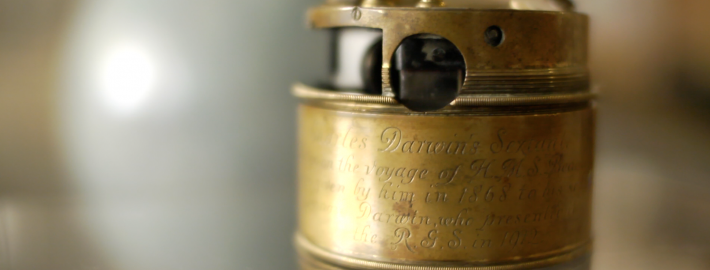The power of objects in learning
Visuals: pictures, drawings, videos, art, and objects can nuance beautifully with learning content – to take us deeper, to explore and understand complex ideas, to italicise specifics, or simply to try and render a window into a slice of reality that we might never otherwise encounter.
But just this minute, sitting in my office, I had a rush of inspiration that takes me back to the power of objects, and so I felt the need to write about it now.
I’m currently working on my second film for the Royal Geographical Society – which is always an incredible treat as I get to film and encounter objects like Shackleton’s Antarctic helmet, the bags of food that represent Captain Scott’s final meal, Livingston’s iconic hat, and (what inspired this blog just now) Charles Darwin’s sextant he used on the Voyage of the Beagle.
As an anthropologist, I’m interested in material culture and theories around this topic informed the way I approached my PhD thesis which was all about family photographs, relationships, and change.
People think family photographs are fixed, but they’re not. They become infused with multiple stories, multiple meanings, that change over time – often alongside very real changes in our lives as relationships are made, broken, and reconfigured (especially with regards to bereavement and divorce).
We imbue objects with the residue of what they symbolise, what they mean, how we are connected to them. I’ve always seen objects as sponges. We can hold them or look at them and be completely oblivious to the stories that lie hidden within.
Or, with their owners or audiences, we can probe, ask, explore through elicitation, and then like a sponge they will pour out their meaning into the world.
There’s a funny thing about objects though…
They can begin as deeply intimate things, but over time they can often shift from personal to social history. This is true of family photographs as social histories gradually take form and then catapult images into a shared meaning that has relevance to both the private and the public.
So looking at the video footage I filmed of Darwin’s sextant, it made me think about how objects can (or could) be used in learning.
Now Darwin is quite an extreme example, because we have all heard of him, and understand how he changed the way we look at life. But that’s the point – we know his story (or at least his impact).
When you hold something, or get right up close to something, that connects you with an individual or event, and the stories pour out, or you come to the object already knowing some of the stories that connect to it; the experience can be profound.
It becomes personal, textured, real. It brings you closer to that individual or time.
Let me tell you a story that relates this idea to someone you won’t know. He wasn’t someone famous, he came from a farming community in Gloucestershire at the front end of the 20th Century.
I was interviewing a gentleman as part of my PhD research a few years ago, and we were talking about the old family photographs he had in his possession.
He pulled out a photograph of a young man (the uncle he never met) and his family standing next to a green house on a beautiful summers day.
The young man was wearing a uniform and the photograph was taken just before he went to serve in World War I.
His name was Arthur, and he was killed during the battle of Passchendaele.
He had taken the photograph with him for comfort and connection, and after he had been killed, his commanding officer had removed the photograph from his pocket so he could return it to his parents.
I’m not ashamed to admit that when I heard this story, as I was holding the photograph of Arthur and his parents, I cried. The gentleman I interviewed was crying too.
I cried because that object, that photograph that symbolised and connected me to a clearly beautiful family bond, also connected me to the battlefield, to the moment of Arthur’s death, and to the unimaginable pain that his family experienced.
It connected me to the stories and histories I already knew of the war, but in a such a profound way, where you could actually feel a tangible sense of time rupturing and collapsing in a moment.
So to bring this back to the perspective of learning, my inspiration to write this blog has been about how others might be using objects for learning in L&D.
When you connect people to objects there’s almost a sense of embodiment of a story, of a theme, It’s an intimate experience.
It’s the same with stories, and indeed this was the subject of a talk I gave alongside Gemma Critchley at Learning Technologies 2015 where using stories for learning videos can create emotional engagement that helps learning ‘stick’.
Organisations often bring in guest speakers to inspire, and I wonder if objects are ever used in those instances, or if objects are simply used on their own, because the power of the stories that reside in them will have impact.
Please do comment below if you have used objects for learning – I’d love to hear examples and stories.


Leave a Reply
Want to join the discussion?Feel free to contribute!